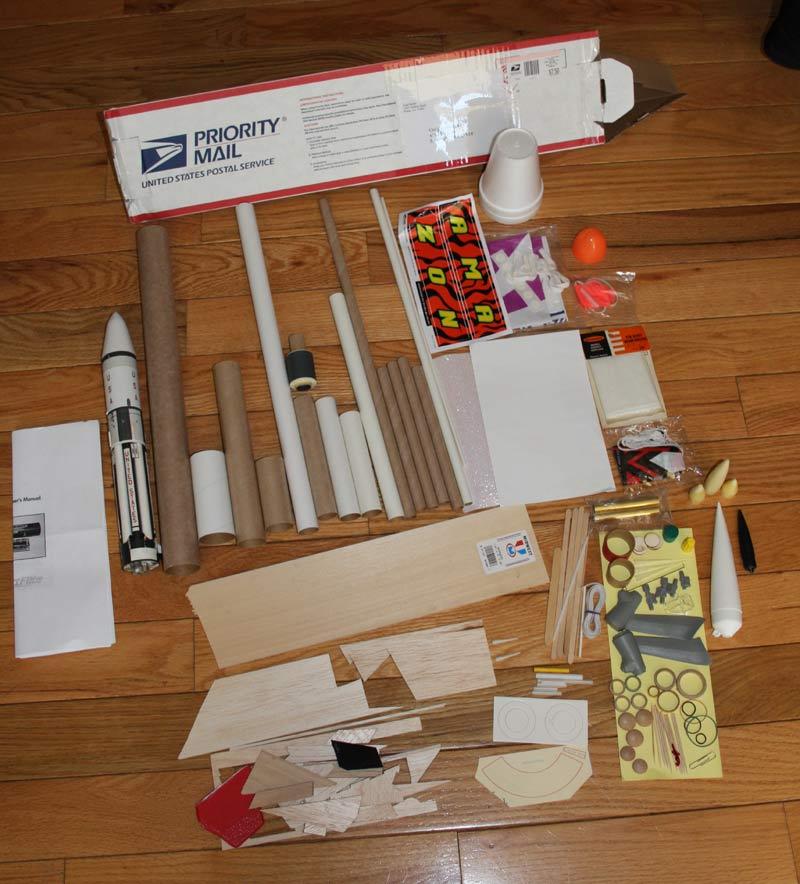Scratch SpaceShipTwo Original Design / Scratch Built
Scratch - SpaceShipTwo {Scratch}
Contributed by Craig Zicafoose
| Manufacturer: | Scratch |
Semi Scale Model- SpaceShipTwo
I received my box of parts and was surprised at how much stuff was sent back in comparison to the amount I submitted for the contest. Some of it should have been thrown out ages ago, some of it was good, but there was clearly enough to build a rocket or two for the contest. I had my heart set on building a boost glider before seeing the box of parts, and was a bit disappointed by the lack of usable balsa once it came. However, there was some balsa included and a nice sheet of 1/8 inch basswood. Surely, I could come up with something. I even contemplated using the box itself for wing or fin material which I usually reserve only for making centering rings.
There was a time or two where I thought about doing something sci-fi. There were plenty of rings, sticks, wood bits, and plastic doo-dads for that, but it’s not really my forte. I love when other people do it, I simply don’t have much experience scratch building that sort of thing.
Not entirely sure what I wanted to do now, I stuffed all of it back into the box and didn’t think too much about it. After all, we had plenty of time until the contest deadline.
I normally spend a week or two building and painting a single rocket from start to finish, then account for any unexpected tweaks to the design, and the dreaded written assignment. A few weeks prior to the contest deadline I thought I had better seriously get working on this before time ran out. I decided to surf the web to get some much needed inspiration.
In addition to gliders, I’m also a fan of flying scale models. I began searching for some scale subjects that may not have been kitted before or have had little exposure. Sci-fi is very cool stuff, but I figured many of the entries might go in that direction, and scale would be more of a rarity for this contest and definitely more up my alley. During my search, I came up with a couple military missiles that looked promising, but the love for boost gliders kept nagging at me.
I remembered a discussion I had with Wes Oleszewski of Dr. Zooch Rockets at a recent club launch. We were talking about X-Prize rockets. At one point in our conversation, I suggested it would be cool to see a SpaceShipOne kit that wasn’t so heavy as the Estes kit and could return via glide recovery. He raised his eyebrows and thought for a second. With little doubt in his voice he said, "You know, that’s probably possible to do." That’s all the endorsement I needed. He’s a busy man with lots on his plate, and several rockets in queue. I knew this wasn’t a project he’d be considering anytime soon and I didn’t push too hard.
After remember that conversation, I thought this contest might be a good opportunity to try out my idea. I began searching for pictures and drawings of SpaceShipOne on the internet. There is plenty of scale data out there for the X-Prize winner, but the reality of what parts I had to work with was setting… the nose cone being the biggest obstacle.
Searching for data on SpaceShipOne inevitably leads a person to pics and articles on Virgin Galactic’s, SpaceShipTwo. Once I saw the concept art for SpaceShipTwo, I was hooked. This looked like an even more promising design for a boost glider. And, I had a plastic BT55 cone in my parts box that could possibly be modified to suit my needs….or close enough for the contest’s sake. I downloaded several photos and press images from http://www.virgingalactic.com and started the process of scratch building. Keep this link handy as you’ll need to download some of the same images I did for your build. I failed to make any templates and you’ll see why later.
I began measuring the picture and began scaling for a BT55, since the PNC-55 cone was the closest thing I had without making a huge project out of it. I had a chunk of balsa from a Zooch Saturn rocket which someone so kindly donated. That cone fits a BT60, but that would require more carving and turning than my skills would allow. And, bigger scale meant more wood needed for wings, fins, etc., which something I needed to be mindful of. So, BT55 it was. If my feeble math skills serve me correctly, this is roughly 1/63 scale, and I do mean roughly. Let’s call this one "sport scale", ok?
Next order of business was to scale the concept art to 1/63 scale and make printouts. I did this with Adobe Photoshop Elements using the ruler provided in the software. Again, not perfect, but sized "close enough" to match my BT55.
Construction started with the nose cone. Someone was generous enough to donate a PNC-55AC. If you know the Cherokee D, then you know this cone. It was much too long to keep it in scale with a BT55, so I began hacking away with my razor saw.
The cone was cut in half. With freehand and a pencil I held the large portion of the cone up to the concept art and drew lines like this:
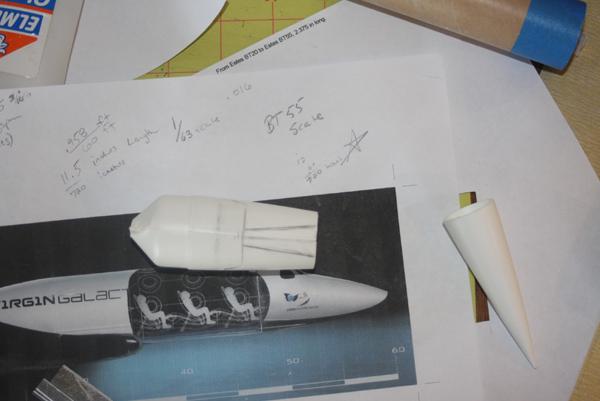
Cutting on these lines will allow for a windshield area and begin a more drastic taper to the nose.
Here it is after the lines were cut out:
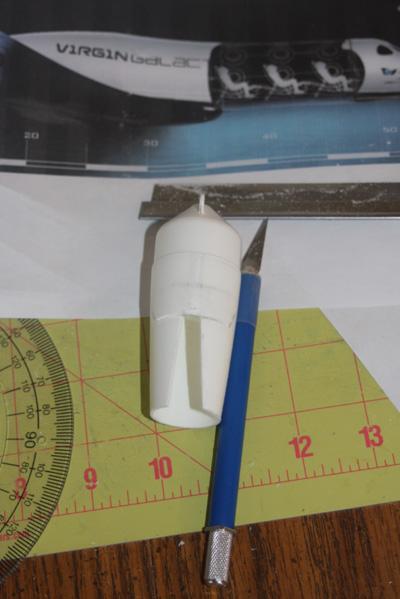
Using Ambroid Pro Weld I fused the two angled cuts together. I used a piece of tape and the remaining portion of cone to hold it together while the cement set.
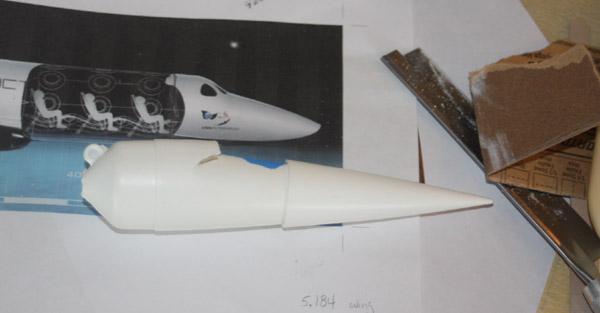
When the cement was dry I began trimming and sanding away at the remaining portion of the cone so it would meet flush with the new cone transition. I also trimmed off about ½ inch from the very tip. Once I was satisfied with the fit, I fused the pieces together using the Pro Weld again. It was still too long for actual scale, but much better. I can live with it.
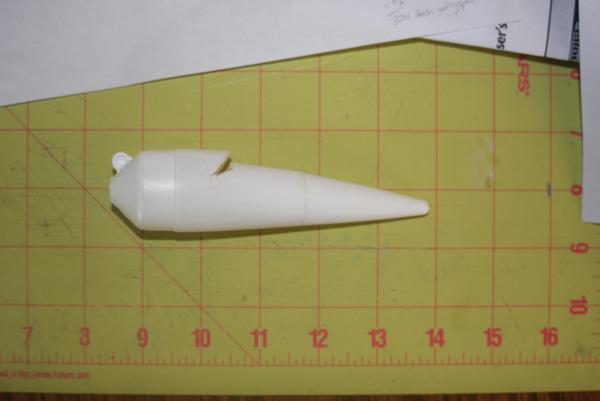
Time for the windshield. I wanted a rounded profile on the windshield so I trimmed and sanded the top edge so it would curve more. I needed something that would close up the hole left in the cone and would form the curve in the windshield. I finally settled on a piece of BT55 to fill the gap and it already had the curved profile I needed. I held the edge of the tube up to the cone and traced the outline, then cut it out with the X-acto.
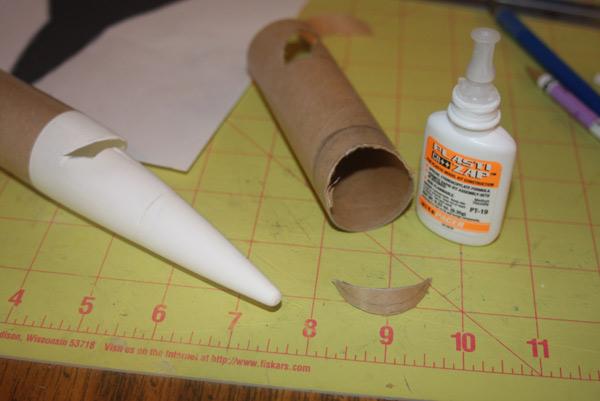
Using plastic safe Plasti-Zap CA I glued the windshield in place.
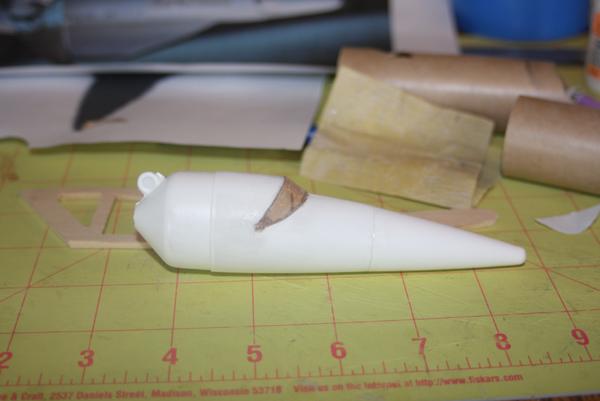
While the glue was drying in the previous steps I took the time to make the vertical booms for SS2 spacecraft. Using the profile view that I obtained through Virgin Galactic, I was able to make a template directly from the computer printout. I traced it to my 1/8 sheet of basswood. The intention is to still make this a boost glide so I drew a frame pattern within the vertical stabilizer, hopefully reducing weight after it’s cut out.
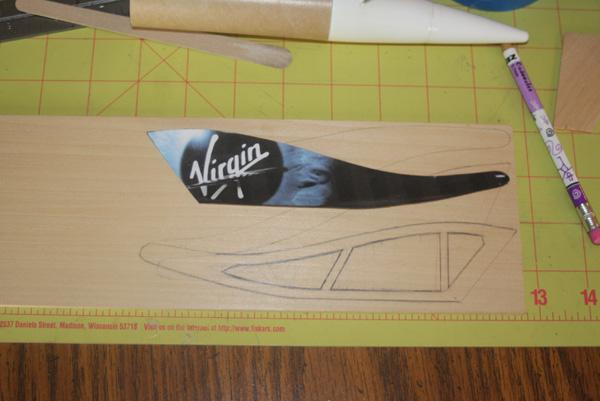
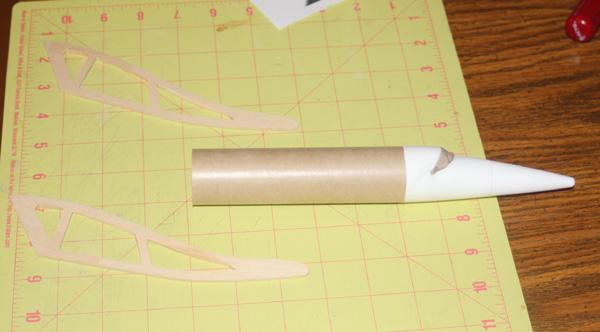
I can skin the fames with the computer paper that was included with my box of parts… 3 sheets from a Perfect Flight Altimeter instruction manual, to be exact. Laying out piece of wax paper underneath of the work surface, I put the frames on top of the computer paper and used thin CA around the edges. Once the glue was dry, I cut them loose from the paper using the wood to guide my X-acto blade
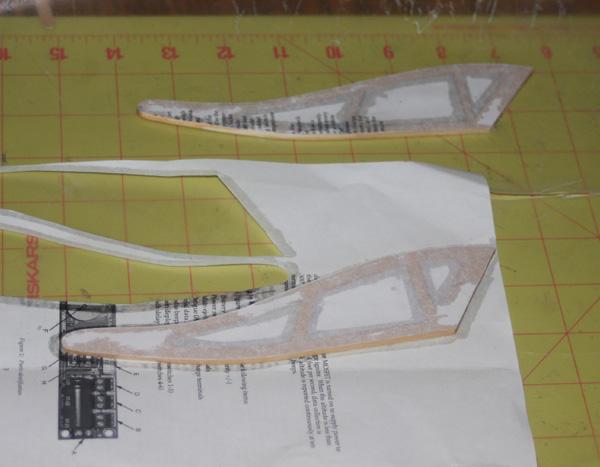
Once both frames were skinned, I soaked the remaining areas of paper with thin CA to help toughen the paper.
Measuring the same computer printout I used for the vertical stabilizers, I figured on 4 inches for the body tube to keep it in my "rough" scale. This turned out to be too short, but more on that subject later. I lucked out and received an 18mm x BT55 motor mount which came completely assembled in my box of goodies…perfect! I removed the aft centering ring and outside coupler and glued it to one end of the section of BT55 using white glue. No motor hook by the way, this is friction fit, baby! (looks better for scale and trying to keep weight down to a minimum)
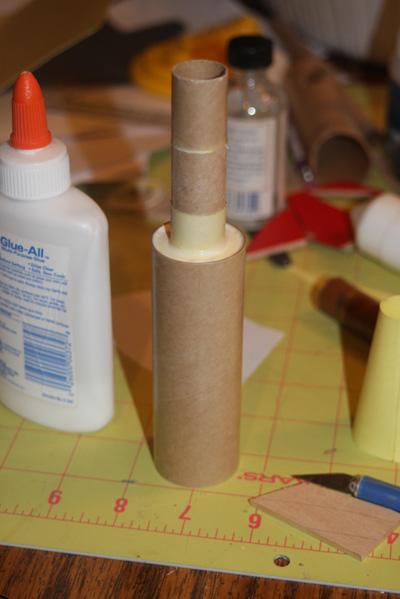
Now for the tail cone. Using one of the handy software tools found on EMRR, I printed out a template for the tail cone. I used 2.375 for the length and used the pre-programmed
tube sizes of BT20 and BT55. Matt Stum’s handy template widget can be found can be found here: ../../tools.shtml .
I traced the pattern onto the lone piece of cardstock I received. Cut out, curl, and glue with white glue. These template generators don’t allow for glue tabs, so you’ll have to make your own.
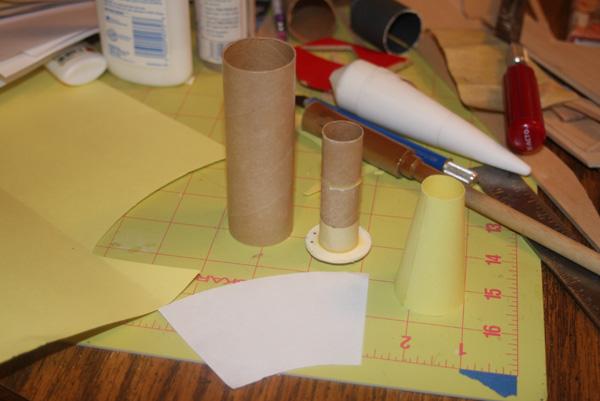
Slide the tailcone over the motor tube so it meets flush with the BT55, then glue in place with thin CA. While I had the CA handy I coated the entire tail cone.
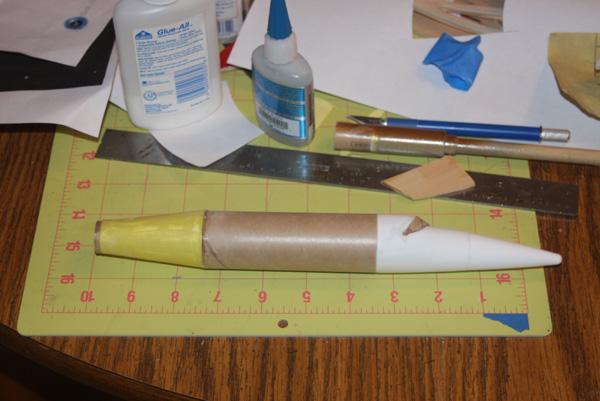
The wing was going to be tricky. Using the "DNA" picture from the SS2 press photos, I created the wings. The wingspan from the printout didn’t quite match the 5.184" I had previously calculated for. I did a little pushing and pulling in Photoshop to widen the wingspan while trying to (somewhat) maintain the aspect ration. Not even close to being a perfect match, but close enough to achieve the desired look of the SS2.
Using a ruler and my mechanical pencil, I began sketching out a frame out onto the wing printout. I cut several ¼ inch strips of balsa from the small scraps of 3/32" I received. These would be my frame pieces for the wings. It would have been nice to cut the wings from two solid pieces of balsa, but I made do with what was available….same as I did with the basswood parts. Using the frame sketch, I cut all the pieces to length which would be needed to assemble the wing, laid a piece a wax paper over the template and began gluing the pieces together with thin CA.
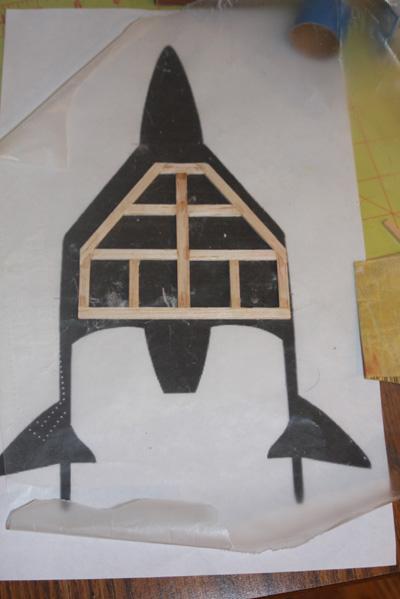
Using the same skinning method as described earlier, I papered the wing assembly. I used the remaining cardstock to skin the bottom.
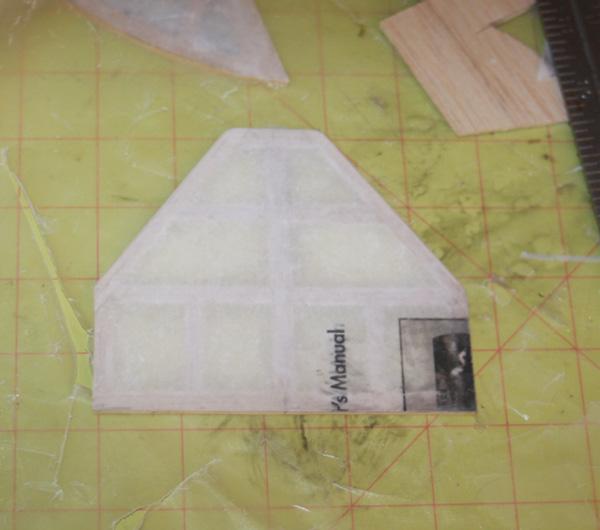
Using a straight edge, I drew a line down the length of the main tube and the center of the wing.. These lines were used to help center the wing on the tube. I glued the wing to the main tube with wood glue. Tacked the front and rear joints with CA.
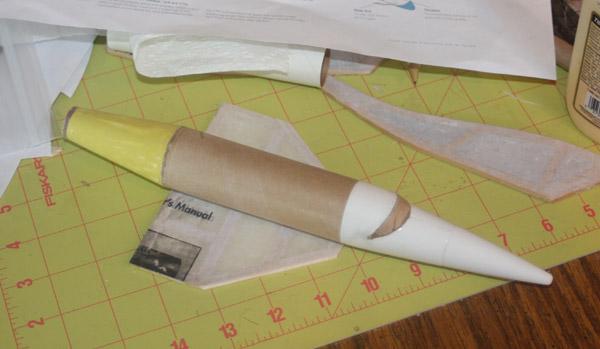
Next, I glued the vertical stabilizers the wings using the profile printout shown here to help with alignment (this is the same printout used to create the stabilizers earlier).

Using the "DNA" printout used earlier to make the wings, I made the four horizontal stabilizers and elevon templates. They were traced and cut from scraps of balsa that were included in my parts box. Used the side profile printout again to help line things up and glue into place…a good eyeball and edge of a ruler helps too to make sure the horizontal stabilizers are perpendicular to the vertical stabilizers.
Since this was supposed to be a glider, I made the elevons seperate from the wings. I wanted the elevons and booms to hinge like the real deal, using a rubber band system(which were included in my box) to pull them upward at ejection. After seeing how far back the CG already was, I decided against it. Getting a straight boost was going to be tough enough as it was. Instead, I glued the elevons in place and opted for a fixed wing. So much for the glider idea. I still think I took a sizable weight penalty using the basswood, paper/cardstock skins and glue, but not sure how much I would have saved going all balsa, but it certainly didn’t turn out as heavy as it could have been. At one point, I thought about using the cardboard mailing box for wing and stabilizer surfaces, but decided they wouldn’t hold up very well and wouldn’t look as good when finished.
And there it is…the SS2 glued together and ready for finishing.
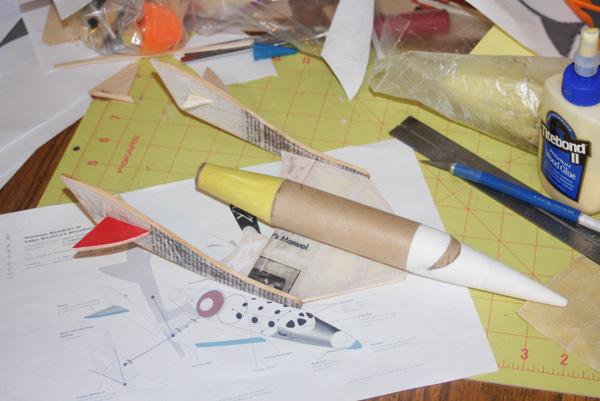
It still needed a recovery device. I installed a piece of elastic and tri-fold anchor to the inside of the tube. Two pre-made Estes chutes were included in my box, one 18" and one 24". I chose 18" and cut a large spill hole. The chute is still a bit oversized, even with the spillhole, but will work just fine for the contest.
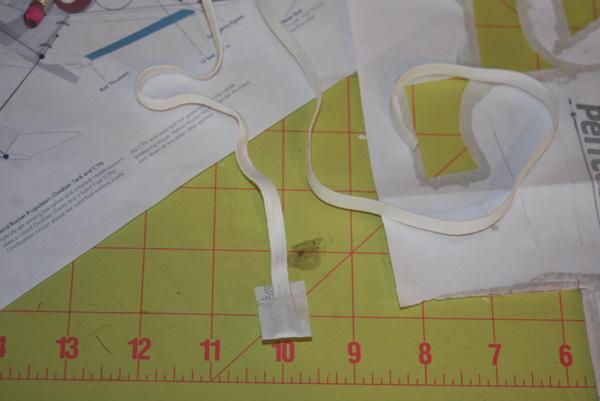
And now, a test flight……The first flight was miserable. I had already added several grams of clay to the nose, but obviously not enough. I flew it on a B6-4 for the first flight. Went up about 50-75 ft., looped a time or two and was still under thrust when it decided to fly downward. Hit the tall hay and blew the ejection seconds later. Surprisingly, no damage whatsoever. The tall hay I had cussed while looking for my Scout was now my friend. Back to the drawing board.
Clearly, this was still tail heavy and needed the CG shifted forward a bit. I achieved this two ways. I wanted to avoid adding too much weight to this, so I temporarily taped a 1" length of body tube to the front and added another piece of clay with a few computer screws added in for good measure. All told, I think there is about ¾ oz. in the nose. The added length is just one more stretch away from the scale factor, but most of importantly, I wanted this to fly properly. Heck, major rocketry vendor take those liberties with scale all the time. In the name of not letting all my hard work go to waste, I figured, I should too.
No computer Sims here folks, just trial and error…. Next test flight(#2)….
Success!!!!!
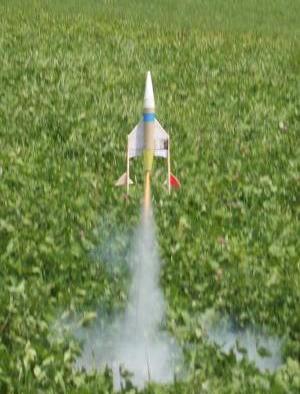
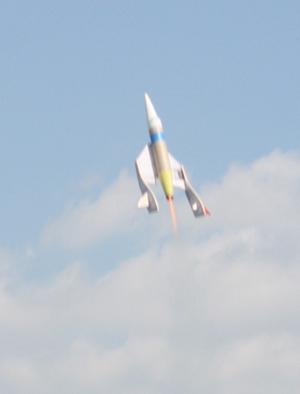

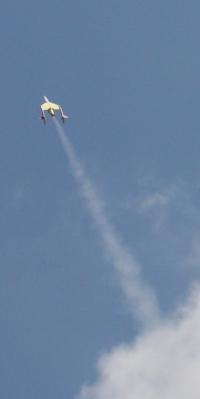
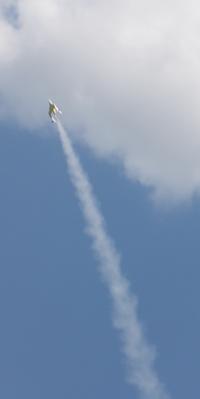
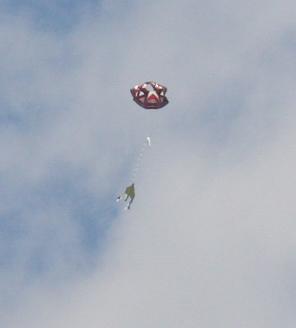
I’d guess it reached about 400 ft or so on a B6-4, very slight weather cock from the light breeze that day, but flying nice and stable now. Beautiful flight. Time to finish this puppy!
I used a piece of the included computer paper to fabricate a thin coupler for the added 1" section of tubing, then CA’d in place.
Fill N Finish on the few exposed balsa parts, tube spirals, and any visible seams. Squadron putty on the nose cone seams and to blend the windshield a little better.
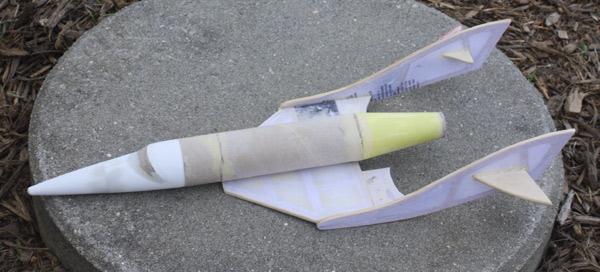
Krylon grey primer under Krylon Gloss White, then masked for the Krylon Gloss Black using Tamiya tape and 3M delicate surface painter’s tape.
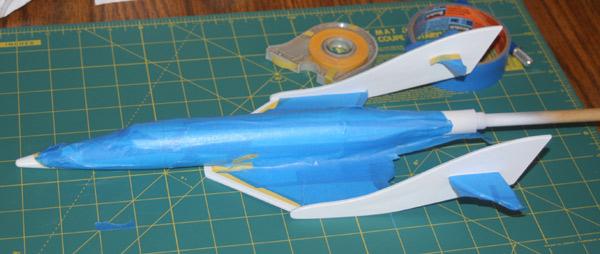
Used those little clear plastic paper reinforcement circles to mask for the circular windows. Hand painted those and the windshield area with Testor’s Gloss black, and the exaust with Testor’s Alminum. There you have it…. the SpaceShipTwo!
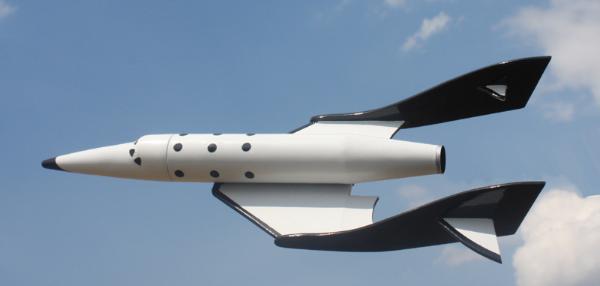
I might print up some decals displaying the Virgin logos and such, using my own decal paper when the contest is over. That should really make this thing pop and give it a more scale appearance.
This has been a fun contest and it put my skills to the test. I normally don’t take on too many scratch projects so this was a nice motivator. Thanks for all who contributed in one way or another to make this contest happen!
 |
 |
